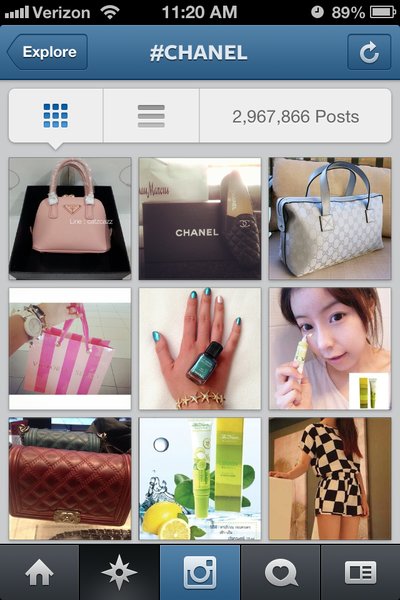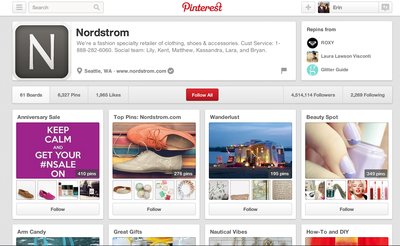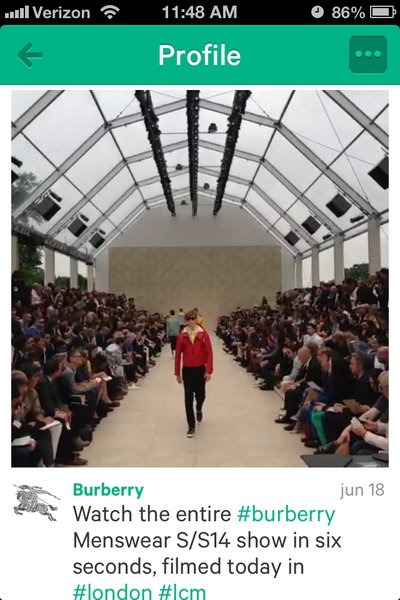Instagram is becoming a core platform for brands to engage with consumers since it registers consumer engagement 18 times that of Facebook and 48 times that of Twitter, according to the latest report from L2 Think Tank.
The "Intelligence Report: Social Platforms" found that the visual component of Instagram has helped the platform grow to 100 million users with the average luxury brand having 100,000 followers. Other visual platforms such as Vine, Pinterest and YouTube have grown significantly and continue to be platforms for brands to deeply engage with consumers.
"For all the mindshare that it occupies, social media ultimately drives very little ecommerce, less than 0.25 percent, and site traffic, less than 3 percent, for prestige brands," said Danielle Bailey, research lead L2 Think Tank, New York.
"This is not to say that social media is irrelevant, but it requires a shift in how brands approach and measure their success on these platforms," she said.
"Rather than direct attribution, social media shines in the secondary effects such as search, customer service, CRM, retargeting, engagement and brand building."
The Intelligence Report: Social Platforms study is a comprehensive report that assesses the presence and performance of 247 brands across 15 social platforms.
Worth 1,000 words
The study found that social media platforms based on visual content engage consumers more than other kinds of social platforms.
Users on Instagram are even interacting with brands that do not have an official Instagram presence.
For instance, Chanel does not have an official Instagram account, but it has more than 2.7 million images that have been branded with the #Chanel hashtag.

#Chanel on Instagram
Louis Vuitton, Michael Kors, Prada and Gucci also have strong branded hashtags on Instagram, but have an Instagram account.
Other visual platforms such as Pinterest and Vine do not have as many users as Instagram does, but are still useful platforms to connect with consumers.
The report found that Pinterest seems to cater to brands in the home and design categories and drives as much ecommerce traffic as Facebook does for these brands.
Nordstrom has the largest number of Pinterest followers out of any luxury brand with 4.5 million followers.

Nordstrom Pinterest
Motion pictures
With Instagram’s recently added video capabilities, consumers and brands have been caught between it or Vine.
Instagram has 40 times the users compared to Vine. Vine has approximately 5,133 accounts and 35 percent of brands surveyed in this report are active on the platform.
However, Vine does have a higher interaction rate with posts than Instagram, with a higher percentage of “likes” per post than Instragram.

Burberry Vine post
Vine and Instagram are not the only video sharing social platforms out there.
YouTube is seeing continuous growth in video views for luxury brands. Dior and Cartier both have videos with more than 5 million views.
The study found that although it is difficult for a video to “go viral,” there is a direct link between the video views on a brand’s channel and the amount of content uploaded.
However, luxury brands should not join new social media if their customers are not there. Marketers need to find where their consumers are and then create a presence there.
"It's not about luxury brands chasing the hottest platform, but rather understanding which platforms make sense for them, determining where they can find the variance by growing sizable, highly engaged communities and focusing efforts there," Ms. Bailey said.
"Facebook remains the platform with the most reach, but it will come at a price," she said. "This is a cycle that brands will continually face as platforms mature and look to monetize their user base.
"It is in brands' best interest to use social media to funnel consumers into their traditional, owned marketing channels to extract the most value."
Final take
Erin Shea, editorial assistant on Luxury Daily, New York
{"ct":"hamZuxWE7uZjw1IYPO\/qTc8D\/4ElasgRmBMUoDQ3por7f8wBJvuUOrmUiK87goMM3oaeriV6ztAzHgHb5CLFxvLYc04Qv0Q1GjgqY8JGgD0U2Rlb+9rxHPBBCx3j6X+OLt+Z+iY4u3pskJaTzG7WN2TlORnxWeMbYrr0mYhoehZibguAAGA9H8+Qp7D6ckmVxXAklplX9gYFGxNS\/S+Y\/6kXnF3Q1sTsyyYcBU+k6t1jXTuEPKE7eyla9DvgB9\/JPel2tTSoENFjxO3XA0sdv1b\/LfUpmzbfhBBZt4f5hbsNy0ZMJcYaaFVkmcHuRC9WSj\/lbgBBcx\/dYl9wl9G3+AWrIuD4cRYV40EBybusvz5a7DeUtAQjjFvyiuxSNwVfz8wkMs8KPxod3A5+PNSmRmVDPYbBRym9JiVjbikXuNaTX08Z1DPgze1Bxf3oeqLH9sCQ54jlxg\/yb5wvLbWACQRh7lnkXx4dhYupTSXA9N2wM3xT1yWdfSgYIt5jWpP6zqkAB7QI\/NG7c7Ay7FRyJS1Zbb23sWxQtgfvuBDqT2YKSZ9cUMutjmT0eWm1PeG6aPYfluFTJSSzmjyvAVd7Ma3w8UUval6kCNA1ca9ZR9ORvcAhbOwSYcKlF8jeMduE8vPaQg3dRS2hJJTzEuUouUad7FF93YS\/4AWZe74nIVqsriqyOUP\/ZaseRkFxUqKbvOCWmP3wOy+EeFY7\/UxYUcafVqYTwnLemuf++8\/kZ9JrUSxIfkT5SDVZIs+fl+PPFh0EY324+Xn0rrD3iyvD7cXaEGSdLiYpkDnwUWzrCaFOJGI8RV8NlGm2\/g7hGko1asdf4V6VuYegbBo7ZtJ1GX\/rSgzd7k56J5SGvLZlRgKUmCXwqQHqk4GI9L6lGN6ShMm89OprW3IYIwfA1p4sW81OPDd1CXRQDKUSCyom\/+OduDHzrOPUqkiWxPVOcUFoZW65ApJ3aOCVTeoHSs6gQ41pHXxe1XEvje2jc\/NFn5NL1A36AN8zs8hBB7M7h6G8l6V+9abU0X\/f3tJNteWlbdaxkMFdTfp0yrh\/05VszwhKmqJCbZI7f+4\/I0746MyFIMoj53hHhyzEX2njsaJYgligZi9VtwDhkmJDv3kEr3x\/+T+eCuUQibxeTGCWHG4sMwpAkHdwrxhEF0NRY1wN99TKBOFPiDAcoRM1AAbpVyhYsGAX3nY0gjOkbvyvtf8YC+f09jETRVJHC+g+fBfnotvz80au9S9iOxK2c072ql19z8LsAtuG9GNJo731TrhBkFsiyQQh7SLc0E2vjdlLsggHqBpbMQ+iTaChepJpuSdYejUY8zHm1Tm\/4nnkvi65wg7v2uhcSrnq5vnHpw7PpC\/QCs+5F3U1+lJX1t4Nl35xpEJhM6jLKOxJsHLPtfCfjtL8AKDlFwHwkEKvx+lNLGIq7knnlOGho+WuZR6qD1mrniHUImVtCE4gZR3t3m8loYb\/88kk\/OXrRcGNj81oXcDwED8ns8EyyXbcBVVGLqLZdpaF+WSEcGFEgFezWlqCmJAMxyaCMu04cYPKqpBKiGtPLgvTKex5VP\/MmCCfO1ncuy390\/TRvHksJg5OrDXEVmBCjRqbpZ9EnKMtiVWAhIZE4pXIOZjd2sBCIXsbEvXZbcHciThzQMoTT1uro7\/nlmUSqdXX8PeMuEN2M2\/O+W93Ur2leGbNJa\/GKyT0d39RROTx3UtU3yzIDclWfQibX2Gv9RebGQilZ0wfDp\/+CtMKY9zJWAhn+5EY9g03QOC+0PrFK0MSa05klBmizlUlDCTLKxzkrWzkuzYvkVCtIp0do7YkTChhXsuRuAtiaqtgYr2FRLNwYA9QJ+nQ9ggwr+R9F9vq0emH6gwXVourSHiebv9CITkE2f1qYOQfZE3ojZQ9Lben2awLUjcVs3CAMFIpLMotr7RA31npAUW+bAWNA+JO0b+s67aqTDvscRqd9\/9SapajfwT92xkBcrCXtV+8txXgY7TmToYkbuPyYnxLBtfyn68Zq07WxWjN9DNfLGdNI25cqB8UZFWC79RNfs0hoMqJACkgRhcIjeR6N9NybE7h8CSPOm7evfsbZk+L0goPeTG8d6r6qNZrktTPPm8efrDgJSGPhF9zL\/ljJubWb3IHyqim1drDth6m+qeJMOV2FtDMKB+JtTM+OxRP10bn25nORGd5kjDIWj4UlB6SNu41YGG2wP73MQnQEAdqxR4pN4mnYviS\/06Duh\/jdh+5hUkE\/Rmb7ULpOiRQsycybBnd5apLZ+1lxkLvOcwl10TrAnDMNmyNDJQ0kGea3f7qX+7zDGn8vXt1BwehsFmV5skSKBMr2VFZgm0HvnmvPuxbWqwsNt+Oj+Fvd9kb8jvyy1HiLc+mq2OY7L2VyWxpR9Blf4cClIwFMfpGcxzvz0\/LBqURP63Ti\/FFgzV743RO8rP4uWrMaDiYRw4NKAjZsUe6Dz1jMQxWxpMvJmkAdSpmoPWJNAw8Et4BaNCAuB1aoRC7UwjJGl0luh1XuPpey8XKC+95UjfJC9RfQDnJwSQ30v8buBtS\/hUYxoV2Oo34PbipQTn1ww0Q8M8TkiqiE0+tVaOiwVdc\/6lgMOQAg+Y93SOIFLQkCnqZQwy2UNI52a+ErdMfGRXPFpOcFHIgtnJgZwqTTLI223KOQSwHLor7gp3h77PhQ2L4sh7tQIQWoOTbSXEshLs\/n3Upvd2NHPu3N1QGB4NSrDcXcTfY+6aeaUxVOD2o3SRyDHy4RBsuK4tI44e2kqL38smZK0m8yuGipzECqxbEFNlt7iNnJrSz4zbvg21EHG9tEHtOApxfMslGpYjbRSSTshAnwtEDfMI\/PTBrVGDIGQUxGk21fklIf4TDXmlLt3MhzfeV+yW63jvhJqi\/kvOqxX3PXxBXVwi4FOWEPpfeFVd7HMkevrQ8zrVzPnDc0+gQ96cdfeBzKgTaB0glvV9afLmbR4mtwoM5ghFOXbyn8i\/zl4BZdLL8Ep+3CpEpzqxlY4tRUPlgEbl3v4keUuPZHgbUYkwLDvd3kjnT4i0jpcIfQLk9sJJd0gAbHqz6o03Mrt2\/oMbOpuNVaULJqiwnTmCeCXPudaYDadW2kYbXP7QmT8jJHypgTulB1S9Q12oxSH9yEIfJLc4BeJskB4FDzZrc3N39H8qz4lJMn0F7wSHXYBJfOPf094FBOGPYjUtGskeVaEbiCwx0BbXruthTFBu1+9Lk9obN1ioiyexZtPzXFinwnOScgAW6xuk\/\/aXyRcUE7PED3PFRUIYBQOw97KtcHj2zmlX4HwTRfK9sz6sO9KFUBg93drdFDDBUB3L984VZ2PhcorVUCfZBkjOubpTBzo\/BuLjMBj+JTVLBIO+eBQoKNbMsFF33h7SvJm2BdT4DFYG+az2bnap1Ok2EDsOIANfeH0JD\/4kglRAb1T3wyAueJF5fBThD3mlwcUtq7XwbEjQXWjP0xpGfkdr2AZe0WEKAcplEslD54y7uiMoBWDh7W+5TFHsMqeMDTkYiA81q7e+3YDEMFqipdh9Wcw\/NEf8UtNZDloCt4T1LiRAhIZakvI1tna3BaxbvuaZ2ceUlUhN8\/VVUwNiN1xnklmOFwyi+a75GbWrdxU1i8\/QWveZFFs\/VUP0aXIb4eiKkwfkRtg3XrsEX31FVqPc59FDtIubooMSUTXFZsEy4RalcyBK\/ma\/M+pOCnIDkGHCSDS6Gon1YQwWURI6ceu0PYNR2VbeGtQLZv1f0cV1igBJgR+2ns7tTVJmEjgD6496Sz\/cH4CbgAbTdIURbd6ie2BqCgkAwOi5GehgNpltb5pHJ2phlvoBJ6H\/sIFIZ7hnjLXK6ciL7EkaSrB8x9hN5ApGmEfWliVtL0bdcvYSk74ueTaSgm7Nx6EJkYCj\/7ZsUNW7yA3F+tNfpVjz6dhNCe5jkG\/\/uqvx5LMcNd9x2twPUyBqsGfR1WQPIXFkpd+Vp7wA6raF\/39XlI21CWyrDKiX7Ot9GWZKQqOVyJt+92L+3QK+Y7RZsHi6YAoIxXX05ptss6Z0XAMhVwSED9ZY7xgUZ5ybn8TH0jMESHscRFlbXuEMSyexde6+8lBv8UeY8i03dBFOTiFJsr6JZ0w9J3lbS2A5rNR6RfzIcnzyWFfy78dK4U9dwkwT8FHbZvAuyTwWdom+dBublGG4qZsBUqOZQMsYVMcebNnKUbqh9Ghar\/FqStLZNFbGIug\/EfEAR3\/LPbDxrsd+4aSD\/cl052PZoiBeo2gq619SqE3wAQgaYBHL7bSL2INdrHyTVIbgQSHNnUgvDoJMr1IrydQZ2mTkCMd9O0Wrpxfyb44iHFNzy\/0j\/X6kwDkq0RC8U0m7iqcSS6nW5S96Nq3Syogt+lXVweT4os4rhAXjVdLHDgU4z2+WSV2r2ZXftFnQNCxwyoyCdEMKFVNn6KE9TOXKqQQl3k90X7z0gCiEt3IGQxqSzAbC\/ASccIuhJz2qXWDeaCa+H1FP\/Ne2d4FIK1I23ELp06o2qxF\/wGBCD2A19IOAcqH1ItNo9VMqz4nz0a37OPTCYHv3pYksRkUlWVks1qBdf2h6\/riTH\/QngArsFllQyO73xf7KxhCGITYXfSQBdiSfRNuRRjLx5Sg5c\/QsNwujDGCT4xh2zc7BbbmNn\/IE4CwgEHOaaS7gp5LXPmwvpmH5fz67yTiOZAx++5dL\/1eVl88+b9bmi3HFQolukxQrRDIRhfWsYMiY+71+PUJ6y8\/bpPm8DshEVsfNNICTes2HQ+EAXjBeDDwqp0BQox7sVtLaV1syUiADPFkRnlpcuzBgno2oTSfCt0mVqCP7XldN+5yEcIO6RiRMj9IG8PT7PnPU1VcSTYDBRlun3QLmZBW5RexXqtxtbVLYkDrNfqvScZi6\/IEbIG+egykBGl4\/xrc0u9GDW74qjaogWeR7icaCcT250nSktwNBHwX7kFz1lYnOuLf5Tt7rjXQbcymjz2mfl4Zj4xtVLW+FN6QF6jNxIm0QdKapEwzzpdhKwZICCXrDqE9wCPasJHYVlPCIDhZnXK0dyKYTaUB+NH5ifXm4h0Fi4UwfyU0C0z731Ay3s8aNDPxhfU6+Z9WWK1oFXr57bQPdUgcQY2s7WTOfdA5Di\/JH+y1sFf3lreD9R0ICwNbNNbjyKxV1tSorfmIYnxvPkg60kfy6s+Xoq\/F9iyebRCCIHIF5NZjERoLxJ2SgTM1np+6BVWmE4xhfdIGH\/uhA27gD+kohtvsZKKnki3EzY0wxllV1FyF7IaJTumYkEVcL4r0sHGwBaFX0E0X+V2iakYQ0ua565muBq14I7sR7On3OXUhLkujxO7icQedOfFTeC6Rf\/ozsr6SfuPOu02zp9bG699fOwsco2oTx8iefc1F\/Ru3f5QbgtXGn1SQroRaWi7D6GddzRXcXQGrIIKzcuYX6cEbXaI6RGlpph8OZrMvAHlc+Zgk0q0lbXZPN\/LhGCa10aLg1nvauEUOy6QrrlviXyF9LC7S2mYjK4j4bB0b0CSAA7o8eLlX3nsx1covPImypFjY2etseaS66xhuA655GV3GN2CUjxgxG1+qXs1wZfFawvE6gqmCttQVDHn6LQAS+kbBaLsTUy3MqJ3BmkhEZ25WcYu8ZxjgUOexImq\/jVx9hzvN0kwrtF\/2t6JC8QV9503qQyUFTLBA4WrONnjxBAEOEegaUFXckU\/y+GMNgIHKUYOTV2b90hNQ9vQEU\/eZyBNOGhairDXfOEm20KmiYl9zha0JujQGDMe6PWN66Et7wTGXI\/Wc1\/eLpS2fylbElVe48U4H4mb9XZs8\/btPa4VYhcFdbEgjta+WtyDwBHnfAvtza4jTJY0GA77OKyOnm3oIqkEtPiC4YICCwzywGIOYW2iE\/qEvH7q7ybR+HoGhJTtvLpVr84\/GxcWNNn+DPE7IdD8TByIUnwoV1WkmpxH0AT38Ku9OjiQgyClvtLMy4lmIcfyAyE7nqisSPXVmmAit6rIyg\/9BPnoAHsdDOzgP5Ja5Nl8hstPh5PnNMJOb1IkYGt08dknm4jyhUv58SwDRenJ8kRuzzuvoOBYV1j8EtCTv7AzpZ5yjS+TBd\/zd0XtDZ5vNk57gWh2s1J6ratB1UttPlNswqgmz+UxUbej3K3P1trhxemNlAnlIp28yunmPppGKZ08D8DRSILyNRC0+VQodkCBDxfqrSiSVTk4beMSluYD3WxjhtSX8VOJKbT+4FK9oY804C8r6fgRRaYcYGw++INoMqDJ\/lpzKCQTF\/WdgkedQKFWGNV+IHr\/71rJAQ6KxPYhQaJ\/SphxIXEan6aOQ5VZQLJJIoyTvcICSeI9XWBWVsDBvm9rUiLf5Do8dRnRntlMiuRoWiO+0lCarvTRS2R\/\/e2\/qyr6E21AVwitvtceoQOVY5FXCQb0iODECzTuedBHfqO4m6f4OUjkcrSDmBil3gO523QiDXfFToCBi79rZ4LXBtWBxFOse2QPx4VBZkQhk\/zVPaAZHrAjNzcMf+XXHu+Lw64uzVvI+e3OMV0U5m9JFo8BFnq9evdGil6KLvgxz6uTakqWQpYasorUsALpup1+2QS\/sPGwMKPds6vkVncrTfMcR+5mon7aLEKhso3j8\/6lmP4ew7yXi+QCzlAUaOC9V7dTIsWawfy7xD0wDYMg1sxGEcKK1Yz8PznNQuL4zTjWq9hPLLKXhPLhJ1wU9Os3IjGDVFWDyPpFCiE\/3vF6CKweL1Vl97592RbcNBjKvou78pOB0PTGjdX9llCu1nTe8lez+\/G6ECZoMq4ftbvLcmtGfJzy2RVSsDEc5ZtmYBuUn9x\/0KMatWGYSdVLntpKSXxtTPGJ\/qunGNOcpzqFgapcxwFAAtTlxVNig7xGoDjEY6rXe6thQjOeFPExaRm4jOuo9ip30eGabgfDuguSGqXxdwlwR6ZUldzOTd0Lfh4PD2P2btfTbgGY2J\/0AEoxmqMItFGfEnDLEj4cY0IoclC+0XLQGXTGMzMYlgfs94TzHl\/Naaom\/d0wP\/aTdnZXqhbCBeuu5loi99gm2RGsypqBtqKrqLJEM5bsfnrqL97NE1gtAHIw1rTWB0KCMmU5ICqZIqdoiwlEjFt9y29UrU9Jg7FaMuXI9UuYNJfFt87lPERUOwvxBUqUV9p1u5rPOrOE0u8f8sxk+L0Eb3+mRBSZDAUqwTiR1tCeUEusgkJXm90IcChBnCEl1Osbj3J4lJ8pf6eCywkV9emAK9TTRCh3do7CcGdqINI8pnkbvcJ\/oiCORBpSHmF4FLX7UDpf7SIrax4jPAJdRdtDTF1KzdAdr+aqppBsSdXcEelcYhMVnjyq89yd5HSdPI3v+pOMhNr3MM+hQGEGgXUQi2JA7kKi7VFLATxSmwdg2sR2aMvS1oOTxY6S2jflKSSY\/r0iAugC+ULfxTiYJk2fRCGqJXns\/XsJBE7xvbRQciR6qUuf1\/AVyPc0Wz9t8GqYn4O2KM+dInVUqfwaBp63c6cDVRIGCVnswBWCvcf\/g0y00190nyuiVnv3tQ7U8L8Y11QrrxmZyKxHcAVEbb6khORT3kdzo0bBUjOTuOjPRSW+Xgglu6qLnqK6IboSqNF8UQu2\/QlKbZH3OOOGCruiVnEW9Wd2dppn3rw7\/QYqy1C2rTHW8KFJubYi7vk\/jv++hJ++MGR1egfoH0j9FQdJdJbAcjxB9KyDc0dSPGg7AFh+6MiJyKFhYrbgtDbOzanTrdKtT8=","iv":"3ef22ed31d68a47da7fa84ba815f18dc","s":"34bbdb517dae32ac"}
